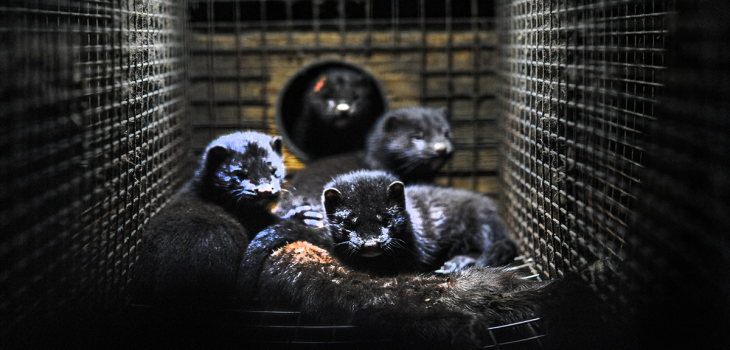The Fur Industry: a corporate overview

Fur production is banned in the UK, and the industry has been on the decline in Europe for years. Yet fur can still be readily bought and sold here, whether from niche London boutiques, or major online platforms like Etsy and Amazon. The COVID-19 pandemic has thrust the international fur trade back into the spotlight, hastening bans in the production of fur, and adding weight to proposals to end its sale in the UK. Yet with the recent announcement of a vaccine for mink and other fur-bearing animals, the industry may just save itself. For more on the background to this story, see part one of our two-part series on the fur trade and COVID-19. In this article, we outline some of the strategies the industry uses to normalise fur in the UK, and provide an overview of companies still selling it.
Thanks to the sustained efforts of animal rights campaigners, fur farming was outlawed in the UK in 2000. The widespread awareness of the cruelties involved in its manufacture led to a decline in its popularity and fashion designers largely avoiding it.
But the industry bribed its way back onto the catwalk. In the 2000s, fur auction houses were said to have, ‘aggressively courted designers, especially young ones, to embrace fur by giving them free samples and approaching them through trade groups — sometimes when they are still in college.’
The strategy proved successful. By the early 2010s, fur was making a comeback with designers and celebs desperately searching for something new and unique, and the emerging herds of Instagram influencers promoting luxury lifestyles and products.
While much of the increased demand in the earlier part of the last decade was driven by the nouveaux riches of China, South Korea, and Russia, it was nevertheless noticeable that fur had once again become less taboo in the West. According to the HMRC, by 2019 the UK was importing more than £55m worth of fur, including £5.3m from China. A quick glance at sites such as Etsy, and there is clearly still custom, even if some buyers feel guilty about their purchases.
One major auction house revealed their strategy for manipulating consumers into buying fur, explaining the bizarre prevalence of pom-pom key rings on major furriers’ websites:
“We start with the young consumer buying a fur key ring, then maybe a little later she has more money for a fur bag … Eventually she buys a full coat…[it’s]…all part of the agenda, to inspire the upcoming generation of women.”
European sellers have also ridden on the green capitalist bandwagon, with many doing their best to rebrand their products as as ‘sustainable’ and ‘natural’. Lobbyists such as the British Fur Trade Association and Fur Europe, discussed below, play a major role in this PR effort.
One other likely reason for the industry’s resurgence during these years, ignored by the mainstream media, is the sustained repression against the UK animal rights movement in the mid to late 2000s. Although the brunt of this was felt by those fighting the vivisection industry, the widespread use of injunctions to prevent protests by animal rights activists was also used to stifle campaigns against major fur retailers such as Harvey Nichols, Harrods and Canada Goose (although the injunction against the latter was later overturned). Campaigners’ previous successes and the impact the clampdown had on the social acceptability of fur is testament to the power of grassroots resistance.
Thankfully however, fur sales in the UK have been on the decline again over the past few years. As the campaigns continue, hundreds of major fashion designers have gone fur-free, and the UK government is even considering a ban on the sale of fur. Now is is a better time than ever to make that happen.
Here we provide a non-exhaustive overview of those working to keep the fur trade alive in the UK.

Giles Roca, CEO of The British Fur Trade Association and former Head of Strategy at Westminster City Council
British & European lobbyists
The British Fur Trade Association (‘BFTA’) dates back to 1919 and describes itself as ‘the voice of UK fur’. A list of its members can be found here. Its CEO is Giles Roca. Roca is a PR man who seems to specialise in helping dodgy industries on the decline, having has previously represented the Tobacco Manufacturers Association. Last year he set up a PR consultancy firm, Capital Counsel UK Ltd, to support ‘highly scrutinised and sensitive industries’. Roca’s background is in communications and strategy at Westminster City Council.
The BFTA’s directors are Steven Hurwitz and Pierre Lipski (see below for more on their business interests), Paolo Borello, and Frank Zilberkweit. Zilberkweit was previously involved in the now-dissolved fur merchants Philip Hockley, a company which was the focus of major anti-fur protests in the late 1990s and early 2000s (protests which were also stifled by injunctions). The BFTA is currently fighting the prospect of a ban in UK fur sales.
While it has been officially registered to Sky Gardens in Wandsworth since 2019, the BFTA and its directors have a history of association with two neighbouring Archway addresses, Brookstone House and Bellside House1. Directors Steven Hurwitz and Frank Zilberkweit have run property businesses of the same names. Six members of the BFTA appear to be registered to Brookstone House.
The International Fur Federation (IFF) is an organisation with offices listed in London and Beijing. The IFF’s role has been described as ‘fighting obstacles to the global fur trade’. Its CEO is former Lib Dem MP, Mark Oaten. Oaten has no apparent experience in the industry for which he is now a global spokesperson and advocate. The IFF runs another platform which is used to promote members’ products, the Business of Fur. LinkedIn states that the IFF’s London office is at 100 Borough High Street, London, SE1 1NL. A list of national member bodies of the IFF can be found here.
Fur Europe calls itself as an association representing all parts of the European fur trade. The organisation is based in Brussels, and has been described as responsible ‘for lobbying for the entire fur sector in Europe’. It organises ‘This is Fur’ events in the European parliament where representatives make speeches, lobby MEPs and run stalls. Fur Europe is working hard on its greenwashing, and its website now redirects to sustainablefur.com.

Mark Oaten, former Lib Dem MP and now CEO of the International Fur Federation
British fur retailers
Major luxury brands
Harrods sells a long list of expensive fur products for the Cruella de Vils of the world, including an £18,000 chinchilla coat, and a hideous bag made of unspecified fur, crocodile, and stingray skin. Harrods is owned by Qatar Holding, a subsidiary of Qatar Investment Authority. The CEO is Mathew Powers.
Harvey Nichols is another Knightsbridge department store and purveyor of fur. It went fur-free in 2004 thanks to the efforts of campaigners, however, it abandoned its policy a decade later, triggering new protests outside its stores. It sells products made from coyote, racoon and fox fur, among others. Harvey Nichols has seven stores across the UK, and six abroad. Its parent company is Dickson Concepts, owned by Hong Kong businessman Dickson Poon. His son, Pearson Poon, is Harvey Nichols’ Executive Director, while Manju Malhotra has just been appointed its new CEO .
Flannels is a luxury department store that sells many fur items, including mink rabbit, fox and coyote products. Flannels is owned by Frasers Group plc, headed by Mike Ashley of Sports Direct notoriety. Flannels has repeatedly backtracked on promises to stop selling fur. As a result, the company has for years been the target of the Stop Fur at Flannels campaign, which has picketed its stores and crashed a fashion show.
Canada Goose is a Toronto-based company which sells glorified parkas, lined with real fur and fetching over £1000 in price. The company uses fur from coyotes caught in leg traps. Its Regent Street store has been the site of protestors opposing its use of fur as well as the treatment of geese whose feathers are used to stuff the jackets. Canada Goose is listed on multiple stock exchanges. Its president & CEO is Canadian Dani Reiss, who owns about 18% of the company. In 2017, PETA bought 230 of its shares, enabling it to file shareholder resolutions against the use of fur and goose down. Canada Goose recently announced that it will only use ‘reclaimed fur’ from 2022, but in view of its history, some campaigners view this with scepticism.
Moncler is a Canada Goose rival that sells fur-trimmed parka-type jackets, for which it uses fox and marmot fur. The company also owns menswear brand, Stone Island. Moncler is listed on the Milan Stock Exchange. Its CEO is billionaire Remo Ruffini, who owns over 20% of the company via his investment firm, Ruffini Partecipazioni Holding Srl. A list of other shareholders can be found here. It has over 200 shops around the world, including 12 in the UK – all in London.
Members of the British Fur Trade Association

Steven Hurwitz, British Fur Trade Association director
Hurwitz Exports Ltd is a British fur merchant active since 1945. It calls itself ‘one of the largest suppliers of all types of fur: mainly mink, fox, sable and wild fur’. It is run by British Fur Association directors, Steven Hurwitz and Pierre Lipski. Its subsidiary, Bleistein & Co., is based in Hong Kong and specialises in supplying Chinese fur to the Russian market.
Rachel London is owned by founder Rachel Zeitlin, who is also Vice Chair of the British Fur Trade Association. It sells fur products made of chinchillas, sables, mink, foxes & raccoons. The company also provides consultation services to others in the industry, ‘drawing on Rachel’s contacts, expertise and knowledge’. Rachel London has a ‘1200sq foot showroom’ in North London that can be visited only by appointment.
Rebecca Bradley creates bespoke fur products ‘from any fur’, restores and alters existing items, provides ‘consultation’ services, and runs a shop selling fur teddy bears, backpacks and more.
The Fur Hot Water Bottle Company. Actually a genuine company that sells £175 hot water bottle covers made from rabbits. The idea for the company came to the founder whilst doing some luxury shopping ‘following a girls’ ski weekend’. One of their slogans is ‘Real fur, real warmth. No conscience’. The irony is apparently lost on them.
Betwitched, a bespoke fur company run by Rozalind ‘Ninx’ Flanagan, aka Rozanne Valerie Bulmer. Flanagan’s company is a member of the British Fur Trade Association, and she has participated in a promotional video for Fur Europe.

Rozalind ‘Ninx’ Flanagan of Bewitched, member of the BFTA
Cara Mila flogs mink and sable coats, including one with a £30,000 price tag. The family-run business has an ‘atelier’ (shop) in Bayswater, London at Unit 1, 32 Leinster Gardens, W2 3AN, which must be visited by appointment.
Bijoux Bijon is London-based fur specialist selling remotely. Owned by Rufaro Cherry John-Baptiste.
Furs of Mayfair sells coats made from mink, foxes, chinchillas, unborn lambs’ skins, rabbits, beavers and sables. Directors’ details here.
The London Fur Company sells many mink coats, among other fur items.
Tatiana Bespoke Fur. Fur bomber jackets for hipsters.
For a fuller list of members, see here.
Other fur specialists
DaymisFurry is a significant Manchester-based fur merchant. It is a huge seller on Etsy (with nearly 2000 items on sale) and Ebay (with over 1,000 items available). The company claims to be ‘inspired by the British multicultural scene’ and is run by 26 year-old Weiwei Shi. DaymisFurry’s Facebook page can be found here.
Lanes of Fur London Fox and raccoon fur products. Also on Facebook.
English Rabbit Fur supplies dog coats made from rabbit fur. On Etsy, Facebook & Twitter.
Mad March Hare makes rabbit teddy bears from real rabbits and sells them on Etsy.

Weiwei Shi of DaymisFurry
Major international sellers
Auction houses
Kopenhagen Fur is a Danish fur auction house and the world’s biggest, selling millions of pelts each year to corporate customers. It has just announced its closure over the next 2-3 years.
Saga Furs is another major fur auction house, based in Finland. The company’s most important market is China, representing 70-75% of its buyers. In 2019, it took over the bankrupt North American Fur Auctions (NAFA), once the largest fur auction house in North America. Saga Furs is listed on the Helsinki stock exchange, though its share price has been on the decline since 2013. In a recent annual report, the company described fur production as unprofitable, ‘after three large producers were declared bankrupt’. Losses have been reported over the past three years, with COVID-19 resulting in a pre-tax loss of €10m in 2019-2020.
Sojuzpushnina is a formerly state-owned Russian fur auction house based in Moscow and St. Petersburg. The company sells pelts from a variety farmed and trapped animals at auctions two to three times per year. Well over 100,000 sable skins can be sold at a single auction.
Fur Harvesters Auction is an Ontario-based auction house which sells fur from animals trapped in the wild. In 2017, the company sold 386,400 animal skins, including foxes, badgers, coyote, otters, lynx, raccoons, and mink.
E-commerce sites
Etsy, the cutesy arts and crafts e-commerce site, is a major platform for fur products, listing well over 100,000 non-vintage fur items for sale at the time of writing. But perhaps Etsy’s most important role is in increasing fur’s social acceptability through buyers’ passive exposure to the many promoted accounts selling fur, and the plethora of accounts selling cheaper, more low-key fur products like cat toys and phone covers. The company has a selective policy on which animal remains can be sold. The US company is listed on the Nasdaq; a list of institutional investors can be found here.
Ebay is another major platform for new and second-hand fur products. It has a similar policy to Etsy, only excluding items made from cats and dogs, and animals considered endangered.
Amazon also provides a platform for fur sellers, and is one of many companies to have sold real fur items advertised as fake.
Miscellaneous
T&S Nurseries is a franchiser with farms across the UK breeding rabbits for meat and selling their fur as a ‘by product’. Rabbit Farm Resistance and Animal Aid have been campaigning against the expansion of the farms, with one in Cornwall successfully opposed last month, and another in Buckinghamshire currently seeking planning permission. It claims to be a family-owned company and is represented by Phil Kerry.
United Vaccines is a specialist US company that produces a variety of vaccines for the fur industry. It is headed by Dutch CEO Wim Verhagen (Facebook page here). Verhagen has reportedly been the director of the Dutch national fur breeders’ association since the early 1980s. United Vaccines appears to be majority-owned by a Dutch cooperative federation of furriers (CFE – Coöperatieve Federatie van Edelpelsdierenhouders).
Beyond Retro is vintage clothes chain which sells fur, among other items, at its stores in the UK and Sweden.
Useful resources & anti-fur campaign groups
Coalition to Abolish the Fur Trade (CAFT), a grassroots group campaigning against the fur industry in the UK.
Coalition Against Fur Farms (CAFF), US-based project which publishes details on fur farms in the country.
The Final Nail, a guide to destroying the fur industry and overview of direct action taken against it.
Fur Free Alliance, an international coalition comprised of national NGOs. It promotes bans on fur farming and encourages retailers to stop selling fur.
Humane Society International, a big animal rights NGO with branches around the world. Frequently reports on developments the fur industry and carries out undercover investigations providing insight into conditions on farms. HSI is currently promoting its Fur Free Britain campaign to end the sales of fur in the UK.
Rabbit Farm Resistance is a campaign opposing the expansion of rabbit farms for meat and fur in the UK.
Respect for Animals, a UK-based group campaigning against the fur trade.
